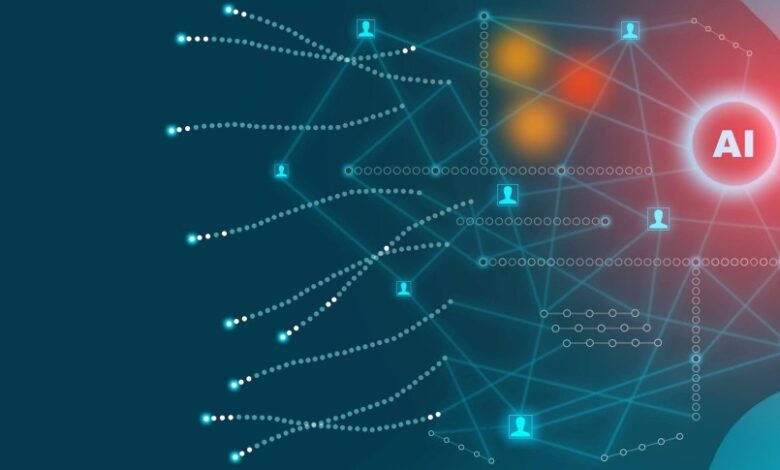
ChatGPT, other generative AI tools, and analytics have significantly transformed the education industry. By integrating AI into the educational system, teachers and educators can streamline administrative tasks such as attendance tracking and grading.
This automation allows educators to dedicate more time to student interaction and personalized teaching methods. Generative AI tools are not just tools; they are catalysts for change.
As per Ms Power User, the AI education market will reach $20 billion by 2027, and Generative AI has proven to play a significant role in shaping the future of education.
What do these figures indicate? They show that generative AI is not just a trend but a transformative force, making learning platforms more interactive and personalized, aligning with the broader goal of sustainable development.
This blog explores comprehensive information about how generative AI transforms the education industry, including use cases, benefits, and limitations.
The Role of Generative AI in the Education Industry
Generative AI, like ChatGPT and analytics, has become an innovative tool. It enables educators and students to create new content, such as writing, images, and music, which was impossible earlier.
It learns from past data and analysis patterns to develop new outcomes and make learning more exciting, fun-filled, and personalized for educators and students.
Generative AI in Edtech empowers teachers and students to think outside the box and play more creatively.
For example,
If you want to learn a new language or new course, count on them. Generative AI will help you understand the language more naturally by providing quizzes and conversations.
Similarly, if you are stuck in your creative writing, chatGPT will help you generate more ideas to transform your writing into a brand voice.
Use Cases of Generative AI in the Education Industry
The education industry is leveraging various generative tools such as data science, content creation, coding, and article writing to enhance the learning experience.
Generative AI tools contribute to increased productivity, creativity, and innovation in teaching and learning.
#1. Update Content Course
Today, the internet is flooded with education-related information, and hence, educators need to update or create content that adapts to ever-changing educational landscapes.
Leveraging generation AI, educators can refine the existing content pattern and enable themselves to update content in one go.
#2. Automate grading and feedback
Earlier, educators faced various challenges in the grading process, as they did manual assignments and assessments, which was time-consuming and led to delays in feedback.
The emergence of Generative AI in the education industry and AI development companies in India emerged as an innovative way to address the challenges and problems educators face.
It enables teachers to evaluate assignments by simplifying grading and minimizing workload. Employing AI tools, educators will allow them to provide detailed and accurate feedback to students so that they can learn from their mistakes.
Create a detailed and innovative learning plan by leveraging generative AI tools.
#3. Design courses
Earlier, creating courses was a time-consuming task for teachers. The traditional content generation method involves manually crafting courses and lessons, leading to errors and frustration. This approach fails to meet users’ diverse needs and personalized touch.
However, with the advent of Generative AI tools, educators and students have potent solutions that help them automate and streamline the course efficiently and accurately.
With the assistance of generative AI tools, educators can generate any kind of content, whether a course assignment, syllabus, or course plan. Integrating AI into other technologies, like AR/VR, provides immersive learning experiences.
Benefits of Generative AI for Students and Teachers

Generative AI tools empower students, enhancing their ability to analyze and understand subjects and fostering critical thinking skills.
This engagement transforms students into active participants in their learning journey, leading to higher engagement levels.
Generative AI is Beneficial for Students
- Increase efficiency in handling educational tasks.
- Supplement their studies
- Generate ideas for group thinking
- Sharpen writing skills
- Receive immediate feedback
- Refine language skills
Generative AI is Beneficial for Teachers
- With the virtual assistant, teachers can provide guidance, answer students’ questions, and clarify information in their absence.
- Educators can generate course and content materials, including question banks, sample papers, lesson plans, quiz questions, writing scenarios, and sums.
- Assist with research by analyzing large datasets, identifying patterns, and generating insights and research directions.
- Create course descriptions, curriculum specifications, learning objectives, or curriculum policies.
For more information on developing these kinds of intelligent assistants, check out our guide on How to Develop AI Copilots.
What are Sort of AI Solution That Can Be Built for Educational Purpose?
There are many types of AI tools used in education.
- Administrative Tools
- Chatbots: Answer student questions.
- Automated scheduling systems: Manage class schedules.
- Engagement and Support Tools
- Game-based learning platforms: Motivate students with gamification.
- It helps you create immersive learning environments, which can be backed by augmented reality (AR) or Virtual reality (VR).
- Accessibility Tools
- Text-to-speech tools: Convert text to audio.
- Language translation tools: Translate materials.
- Speech recognition tools: Interact through voice commands.
- Personalized Learning Tools
- Adaptive learning platform: Based on the skills of the students and the demonstrated content, they are adjusted based on the student’s performance.
- Recommendation engines: Suggest resources based on interests.
- AI-powered tutors: Offer personalized instruction.
- Assessment and Feedback Tools
- Automated grading systems: Grade assignments.
- AI writing assistants: It emerged to offer innovative features like grammar and feedback style.
- Performance analysis tools: You can analyze student data to predict their performance through these tools.
Real-World Examples of Generative AI Apps in Educational Industry
1. Cognii
Cognii is an AI tool that is highly popular among educational institutions, both educators and students.
It provides insights and analytics to students and teachers. Dee Kanejiya designed Congii, an artificial intelligence assistant.
Features
- Provides accurate assessments within seconds from the given topics and subject matter.
- Provides in-depth knowledge about the subject matter.
- An interactive approach is offered to the students.
Price
It is free for everyone. If you want to learn more about the features, you can contact the team to purchase a paid plan.
2. Summarize.tech
Summarize.tech is powered by AI and designed for remote learning and online education. It allows the subject matter to get the theme video format.
Features
- It summarizes any lengthy YouTube video and example lectures in a short and understandable format.
- Quick and easy to use.
- Summarize.tech increases productivity and education.
Price
- A Free plan is given.
- Paid plan- $10/month.
3. Quizlet
Another more effective AI-powered education tool, Quizlet, was developed by Andrew Sutherland. This tool helps educators create quizzes, flashcards, practice questions, etc. for better understanding.
AI-powered tools like Quizlet produce organized subject matter for memorization, presentations, or exams.
Features
- It provides an option to create flashcards.
- Also provides facility of practice tests to score better marks in exams.
- It makes studying even more productive and also makes study time for students.
4. Curipod
To create more interactive lectures and presentations, nothing is better than curipod. It is designed with great features that enhance the user’s work. Backed by critical thinking, it helps to produce interactive lessons. It can also be used to translate content and for meetings and workshops.
Features
- It helps users to translate for various text samples.
- Teachers can quickly generate AI lessons and activity generators.
- Teachers and students can also have an interactive session on this platform.
Final Word
Artificial intelligence has transformed the education sector and changed the way we learn and teach. AI-powered generative education and e-learning software development services have proven beneficial for teachers and students.
Generative AI tools for Edtech help teachers and students in many ways, such as providing guidance, answering students’ questions, and clarifying information in their absence. It can lead to easy and hassle-free learning. These tools are available to everyone anytime and anywhere.
Using Large Language Models in education offers personalized learning, adaptive content, and real-time tutoring. Our large language model course will help you learn how LLM is assisting you in the education sector.
By realizing the importance of generative AI tools, do you want to develop education software? Hire mobile app developers in India to create intuitive and engaging learning applications at the best market value.





